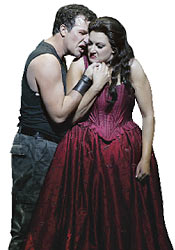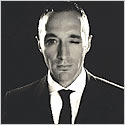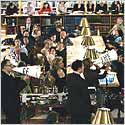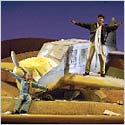
Best Vocal Performance
Cecilia Bartoli
Perhaps the only opera personality today whose huge popularity affords her the luxury of singing anything she pleases, Cecilia Bartoli came to Carnegie Hall, presented “Forbidden Opera”—a collection of obscure eighteenth-century Italian arias—to a sold-out house, and left just about everyone dazzled. Some think that Bartoli is overhyped, but vocalism on this level of virtuosity and musicianship deserves every cheer it got.
2 Diana Damrau may well be the Met’s next big star, if her awesome coloratura technique and winsome stage charm as Richard Strauss’s flirtatious Zerbinetta in Ariadne auf Naxos is a fair example of what’s to come.
3 René Pape’s wicked ways and seductive vocalism as Méphistophélès in the Met’s new Faust production was just about the most charismatic basso turn hereabouts since Cesare Siepi or Ezio Pinza sang the role.

Best Opera Revival
‘The Mines of Sulphur’
A gothic tale of plague, apparitions, and murder on the moors, Richard Rodney Bennett’s 1965 horror opera was a big hit when new, but audiences forgot about it until the Glimmerglass–City Opera revival reminded us just how effectively its accessible but harmonically twisty and eerily textured music serves the drama. An excellent Chandos recording of the production (with much of the same cast) now serves as a permanent reminder of this chilling and dark opera. 2 ‘Così Fan Tutte’
The Met brought back its production in anticipation of Mozart’s 250th-birthday year, an enchanting performance in which sheer musical excellence was paramount.
3 ‘Cyrano de Bergerac’
Franco Alfano’s opera came to the Met for the first time as a vehicle to accommodate Plácido Domingo; what a surprise when the opera itself turned out to be so heartbreakingly beautiful.
Best Instrumental Performance
Pierre-Laurent Aimard’s Carnegie Hall Recital
Once considered a new-music specialist, Aimard in this recital proved he is a great deal more than that: a protean keyboard personality able to illuminate a wide-ranging repertory, from Ravel’s prismatic Gaspard de la Nuit to Schumann’s ultra-romantic Carnaval. And who else would dare play thorny music by Pierre Boulez as an encore? 2 Earl Wild Making few concessions to the passing years, Earl Wild celebrated his 90th birthday with a piano recital in Carnegie Hall by offering a veritable master class in Romantic style.
3 Ivan Moravec Czech pianist Ivan Moravec, a much-too-infrequent visitor, gave an exquisitely tailored interpretation of Mozart’s Piano Concerto No. 25 with the Orchestra of Saint Luke’s under Donald Runnicles in Carnegie Hall.
Best Orchestra
The London Symphony Orchestra
Whenever the LSO under Sir Colin Davis appears in Avery Fisher Hall, Lincoln Center’s “Great Performers” series never seems more aptly named. This year, the orchestra, with its resident chorus, performed the Verdi Requiem in a deeply moving performance of whiplash accents and broad lyrical sweep that went to the core of this gripping spiritual drama.
2 James Levine and the Boston Symphony
Only into his second season with the BSO, James Levine already seems to have reinvigorated the orchestra with his innovative programming and infectious rapport with the musicians.
3 The Chicago Symphony, on the other hand, is in peak condition but will soon lose Daniel Barenboim. His successor may find it difficult to equal this maestro’s magisterial command of the great German symphonic classics.
Best Series Programming
The New York Festival of Song
Every program by NYFOS is a fun musical adventure, exploring some of the most fascinating byways of the song literature. This past year has taken us from despairing protest songs composed in the depths of the Soviet underground to the antic but always life-enhancing world of the Spanish zarzuela. Among the other goodies coming up are evenings devoted to works by Dorothy Fields and Fats Waller and a potpourri that begins with Monteverdi and ends with the Beach Boys.
2 Leon Botstein
Trust Botstein to tweak every American Symphony Orchestra concert program with some intriguing discoveries from the past, all thematically related.
3 Focus! Festival
For new-music fans, nothing quite stimulates like the Juilliard School’s annual weeklong Focus! Festival as it examines offbeat trends all over the globe.
The Short List
Best New Audience Draw
The Fall for Dance Festival at City Center Arlene Shuler, City Center’s brilliant CEO, figured out an answer to the old question of how to fill seats with new, diverse audiences. City Center’s six-evening, $10-a-night festival put emerging troupes onstage with the best-known companies in the world—and sold out again in its second year.
Best Music Programming Before 1800 or after 1990
Miller Theatre, Columbia University Though Carnegie Hall’s Zankel Hall is certainly a contender, Miller Theatre’s executive director, George Steel, has been the champ at parlaying his own enthusiasms for new and early music—he sang countertenor in vocal ensembles before taking the helm at Miller eight years ago—into artistic success. Miller regularly lures concertgoers above 110th Street with first-rate performances smartly packaged and grouped, like “Composer Portraits” (programs focusing on a single contemporary composer, a device Miller recently took national), “Bach in Context” (pairing Bach with his influences and followers), and the “Early Music” series.
Best Opening Night
New York Philharmonic
Musicians in the Phil have said they feel like they’re playing behind a scrim in Avery Fisher Hall—that the public never gets to hear the real orchestra. But that night in September, playing Beethoven and Richard Strauss, they were on fire, fully keeping up with the young pianist Evgeny Kissin, who delivered his usual stellar performance. And at 75, Lorin Maazel led the group with the energy of a 25-year-old.

Best Meredith Monk Tribute
Theo Bleckmann at the BAM Café
In honor of her 40th-anniversary season, 2005 was studded with celebrations devoted to the avant-garde singer-composer-choreographer-filmmaker. But few were like the evening at the bam Café conducted by Bleckmann, a vocalist in Monk’s ensemble and an odd and brilliant new-music and cabaret singer. His rendition of Monk’s 1975 “Gotham Lullaby” was so beautiful it hurt. And his version of “Chewing Gum,” a forties commercial jingle made famous by Monk’s mother (“My mom gave me a nickel / to buy a pickle”), was adorable—and stuck in our heads for months.
Best Freebie
Dance Theater Workshop’s 40th-Birthday House Party
DTW has ferociously fostered choreographic creativity and experiment since 1965. This year, the company marked its birthday with 40 performers scattered throughout its building—circus dancers somersaulting down an office hallway, drag queens in office cubicles, and free wine in an upstairs rehearsal studio—and all of it open to a squeezing-room-only public.
Best American Composer Over 85
Elliott Carter
Milton Babbitt is a youngster next to Carter, who turns 97 this month and just won’t stop writing. His new Three Illusions recently got its New York premiere with the Boston Symphony, and plans are well advanced for the 2008 centenary celebrations.
Best Night at the Ballet
“Watching Ligeti Move”
Christopher Wheeldon’s three ballets set to György Ligeti’s music premiered over four years in different cities. Putting them all on one program (at the Miller Theatre, co-produced with Works and Process at the Guggenheim) meant a rare chance to watch dancers from the New York City and San Francisco ballets up close. Backed by the excellent pianists Michael McGraw and Cameron Grant as well as the Flux Quartet, the program was a perfect way to break in the theater’s new dance-friendly stage floor. In fact, three shows weren’t enough to handle the crowds. How about a reprise?
Best Science-Art Crossover
Laurie Anderson’s latest extravaganza at the Brooklyn Academy of Music, The End of the Moon, was the result of her year as NASA’s first artist-in-residence. Nothing this post-punk counterculture sibyl has dreamed up has been more whimsically lyrical, friendly, or wise. We’re still pondering her observations on the nesting habits of gay penguins.

Best Adaptation of an Extremely Unlikely Source
Nico Muhly’s ‘The Elements of Style’
Composers drew inspiration from French storybooks and the Manhattan Project this year, but a grammar guide? Muhly, a 24-year-old Juilliard graduate, brought a soprano, a tenor, an amateur percussion ensemble, and a few professional musicians into the New York Public Library for the first-ever music performance (scheduled, at least) in the building’s grand main reading room, introducing a work that was not only whimsical but at times even romantic. Maira Kalman, who illustrated the book’s new edition, accompanied them on eggbeater and sugar bowl.
—Peter G. Davis and Alicia Zuckerman
The Year that Opera Went Pop

Writing operas based on popular successes in other genres isn’t exactly new—Verdi and Puccini, among others, did it rather well—but composers seem more eager than ever to take high-profile novels, plays, or films and try to make them sing. In New York alone, the City Opera recently offered The Little Prince, Rachel Portman’s adaptation of Antoine de Saint-Exupéry’s much-read children’s tale; and Tobias Picker’s An American Tragedy, based on the Theodore Dreiser novel, is currently on view at the Metropolitan. Other heavily promoted new operas with instantly recognizable names include A Streetcar Named Desire, Sophie’s Choice, The Great Gatsby, and A View From the Bridge. More are surely on the way.
Although few of these ambitious works seem destined for immortality, it would be risky to write them all off. Many of today’s favorite repertory operas were flops when new, and it sometimes takes years before an opera really catches on. Still, great literature from the past often sits uncomfortably with modern compositional styles that discourage passionate flights of song. The struggle to transform a novel or play is tougher now than it was in Verdi’s day, when operatic forms were more defined and composers seemed far less inhibited about radically adapting existing texts to suit their musical requirements.
That may be one reason why John Adams’s Doctor Atomic was the most anticipated, heatedly discussed, and lavishly praised new opera of 2005. This meditation on J. Robert Oppenheimer and the atom bomb, which premiered in San Francisco this fall (and is presumably headed for New York, though nobody will say anything concrete), is quite literally torn from recent American history rather than borrowed from a famous work of fiction—the libretto, in fact, consists mainly of contemporary documents, leaving Adams all the room he needs to weave fantasias and build musical climaxes according to his own sense of operatic proportion and drama. It takes a bold spirit to create an entirely original opera these days, and by doing so, perhaps Adams will reverse a trend and point opera in exciting new directions.
—P.G.D.
The Industry Award
Joe Melillo, Brooklyn Academy of Music
During the off-season, executive producer Joe Melillo leaves his office and becomes a globe-trotter, seeking out provocative, contemporary artistic treasures for the Fort Greene stages of the Brooklyn Academy of Music. Manhattan audiences happily crossed the river this year to see dance from China, Germany, Brazil, and Israel, and to hear the outer-space-inspired vocalizing of NASA’s erstwhile artist-in-residence Laurie Anderson, Philip Glass’s latest symphony, and the Brazilian pop sensation Daniela Mercury. BAM’s devotion to hometown talent was also evident in a three-year commissioning project with Bang on a Can composers Julia Wolfe, David Gordon, and Michael Lang, resulting in some stirring multimedia-music-theater collaborations. Choreographer Mark Morris, who set up shop across the street four years ago, is an annual presence, and dancer-choreographer Wally Cardona made his bam debut this month, with a stage full of four-foot-high, precariously balanced posts and a theater full of boom boxes. (Cardona says that when he was asked to create a piece for the 2005 Next Wave Festival, he was so blown away that he didn’t believe Melillo at first.) The Next Wave Festival paved the way for the Lincoln Center Festival, which began thirteen years later, in 1996, and nicely picks up the slack during the quiet summer months.
—A.Z.